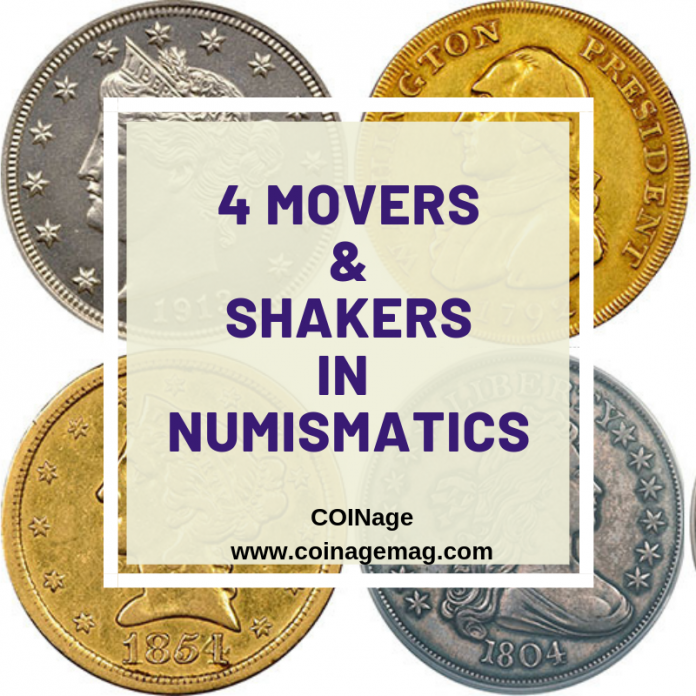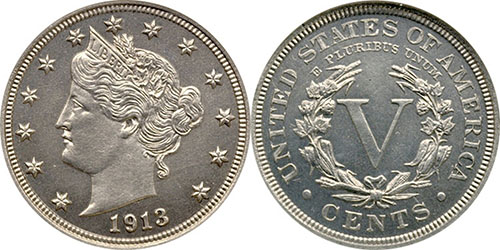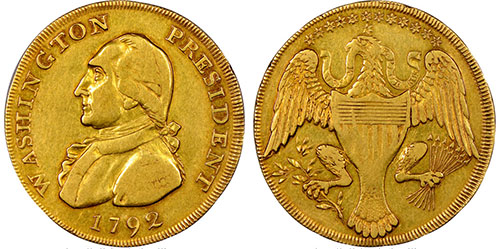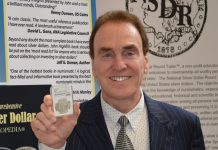
By Antoinette Rahn
It’s that time of year again. I realize if you are a parent or grandparent ‘that time of year’ could mean, post-holiday insanity prompted by children who are on winter break and coming off the high of holiday hoopla. It could also signify the time of year when you reflect on what occurred in 2018 and what you are hoping/planning/seeking to occur in 2019.
While both scenarios are fitting, neither is the subject of my ‘that time of the year’ statement. I’m referring to the Professional Numismatists Guild’s (PNG) annual summary of happenings in the rare coin market. The PNG released its report Dec. 27, 2018, and as in most years, it provides an intriguing review of market movement and serves as a great reminder of some of the most notable numismatic moments of the year.
Among the highlights of the report:
• $4 billion = Estimated overall activity in the U.S. rare coin market in 2018 (not including the U.S. Mint or bullion coins – ie. gold and silver American Eagles)
• $345 million = Aggregate prices realized for all U.S. coins sold at major public auctions in 2018.
• 7 = Number of U.S. coins and banknotes that sold for at least $1 million at public auction in 2018.
The PNG, which is a nonprofit organization composed of a number of the United States leading rare coin and paper money dealers, posses its year-end questionnaire to auction houses. The following companies responded to the questionnaire: Archives International Auctions; Ira & Larry Goldberg Auctioneers; GreatCollections Coin Auctions; Heritage Auctions; Kagin’s, Inc.; David Lawrence Rare Coins; Legend Rare Coin Auctions; Sotheby’s; and Stack’s Bowers Galleries.
With that, here are four examples of coins and currency from the $1 million ‘club’ of 2018 as reported by PNG, as this week’s Movers & Shakers in Numismatics.

1913 Liberty Head Nickel, Proof-66 (PCGS). CAC.
Presented for auction Aug. 15, 2018, by Stack’s Bowers
Sold for $4,560,000
This coin is a bit like the valedictorian, star athlete, and most talented musician of the coin class of 1913, all rolled into one. It’s reportedly one of the most viewed coins, appearing in countless exhibitions, and arguably the finest of the five (yes, just five) Liberty Head nickel specimens struck in 1913. Two of the five are currently in museums, the Smithsonian and the American Numismatic Association Museum.
As impressive as its pedigree, its mysterious origins are equally interesting. Although there is reportedly no documentation regarding the issuance of the 1913 nickels, as with any good mystery, theories abound. Some of the theories, as presented in the Stack’s Bowers catalog description include: The coins were struck as a means of exchange for coins in the Mint Collection, one of the U.S. Mint’s coiners took to striking the coins privately and they ultimately ended up on the market, and the desires of a wealthy collector to have exclusive coins lead to the coins being struck.
Regardless of what prompted the coin to be struck, its journey through the annals of numismatic history and provenance demonstrates its importance. This specimen hails from the Dr. William Morton-Smith/Louis E. Eliasberg, Sr. Collection, acquired in 1996 and 1948, respectively. Prior to the late Mr. Eliasberg, Sr. featuring it as one of the showpieces of his historic collection of U.S. coins for more than a quarter century, it was in the hands of Eric P. Newman. In fact, according to the auction catalog description, Mr. Newman purchased all five 1913 Liberty Head nickels for the single price of $2,000.
There is more to this story, and it is definitely worth visiting Stack’s Bowers auction catalog to learn more >>>

1804 $1 Original PR62 (PCGS)
Presented for auction June 14, 2018, by Heritage Auctions
Sold for $2,640,000
It’s not every day ‘The King of American Coins’ crosses the auction block, but when it does, well, it certainly makes an impression. Such is the case of the Mickley-Hawn-Queller specimen, which changed hands during Heritage Auctions’ main event held during the Long Beach Expo in June of 2018.
This specimen has been the subject of research and appreciation for many, many years. The impetus for the strike of a complete set of proof coinage was as diplomatic gifts from the U.S. to leaders of Siam and Muscat, according to the Heritage Auctions’ catalog description. When the 1804 silver dollars were struck the coiners used dies carried over from previous years and the obverse did not include the date. This would serve to become what would be later known as the Class I or “Original” 1804 silver dollar.
When the U.S. Department requested the coins as part of its diplomatic gifts in 1834, an unfinished obverse die was discovered from the 1800-1804 time frame, and it was used after the date was punched prior to striking the coins. The variation between the 4-punch of earlier strikes and those of the modern process created a key element of distinction.
There is a great deal more about the various ‘Classes’ of 1804 silver dollars, and ownership of this coin, which reportedly inspired what many refer to as one of the earliest rarity scales in numismatics, according to the description in the auction catalog.
A visit to Heritage Auctions’ site to read the description in its entirety is a great education in the history of this ‘King of Coins.’ Visit the site >>>

1854-S Five Dollar Liberty Half Eagle XF45 (NGC)
Presented for auction Aug. 14, 2018, by Heritage Auctions
Sold for $2,160,000
The scarcity of the 1854-S Liberty half eagle, with a mintage of just 268 examples, makes it a unique survivor. As history reveals, the half eagle is among the early coinage struck at the young San Francisco Mint, which opened in 1854 and promptly encountered a series of operational hurdles, challenges involving acquisition of materials needed for minting coins, and the public’s preference for larger denomination coins — which was a driving factor in the Mint opting to move on from quarter eagles and half eagles.
As the story goes, according to the lot description in Heritage Auctions’ catalog, it was believed the 268 half eagle coins were coined largely to test the newly received dies and coin presses. I realize this is not entirely similar, but when I read accounts like this where a quantity of heralded coins is the product of an early mintage process, what immediately comes to mind is when the first copies of a newspaper would roll off the presses. As a young journalist working for a small-town newspaper, the paper’s entire operation was housed in a single level building. The back part of the building housed the printing press and the inserting machines. In all honesty, it didn’t matter if it was the first time I watched the process or the 100th, the sound of the bell as the press started and the smell of ink filling the air always generated an excitement unlike any other.
I’m not saying the folks of the San Francisco Mint felt that way, but something tells me its possible. Based on the details shared, it seemed they were working hard to establish their operation as an important contributor of U.S. coinage, and they were doing so while facing a few ‘growing pains’ as the catalog description describes. I see the story of the 1854-S Liberty half eagle as a unique and dare I say, inspiring example of perseverance in those who believed in the work of the SF Mint and the keen awareness of numismatists of the past and present, who recognized a treasure.
As is the case with all of these coins, there is so much more to this story. It is definitely worth your time to check out the catalog description for this coin at Heritage Auctions >>>

1792 ‘$10’ Washington Gold Eagle Pattern XF45 (*NGC)
Presented for auction Aug. 14, 2018, by Heritage Auctions
Sold for $1,740,000
As I’ve said before, every coin has a story to tell, and this coin may be the prime example of this truth. The origins and early ownership of this coin have been debated since 1855, which is the year records reveal the first indications of numismatic research into the subject.
Among the matters debated over the generations is if the coin was struck in the U.S. or Britain, the identity of the engraver, what can be gleaned from the idea that impressions of the coin were discovered in gold, silver, and copper, and whether the coin was actually struck for and ultimately carried by President George Washington, himself. If you’ve heard mention of ‘Washington’s Pocket Piece’ it is this coin of which people are referring.
Again, these topics and more have fueled extensive research by an impressive stable of numismatists and numismatic historians over the years, including the man from whose collection this example was offered at auction, Eric P. Newman. If you are new to coin collecting, I encourage you to look into the life and contributions of Eric P. Newman. His passion for numismatics was a life-long endeavor, which began with the gift of an Indian head cent by his grandfather. The rest, as they say, is history — a history that the numismatic community benefits from each and every day. The 1792 ‘$10’ Washington Gold Eagle Pattern coin was reportedly Mr. Newman’s favorite. That’s saying a lot, given the unparalleled collection he amassed during his lifetime, the depth of research Mr. Newman conducted, and his incomparable devotion to numismatic education.
Prior to its sale in August of 2018, just eight conservators had the honor of its ownership. Mr. Newman acquired the coin in 1942, and the August 2018 sale makes the first time it has been offered at public auction since 1890. That is 128 years. Wow.
Of course, there is a lot more to this story, because every coin has a story to tell, exactly. To learn more about this coin, its provenance, and a bit more about the iconic Mr. Eric P. Newman, be sure to visit this page at Heritage Auctions’ site>>>
As an added bonus, each of the catalog descriptions for these historic coins includes a bounty of reference recommendations as well.
If you are looking for a list of ‘must read’ numismatic books for 2019, look no further than the descriptions for these 4 Movers & Shakers. Also, be sure to visit the PNG site to learn more about this organization and the work it and its members do within the numismatics community.














